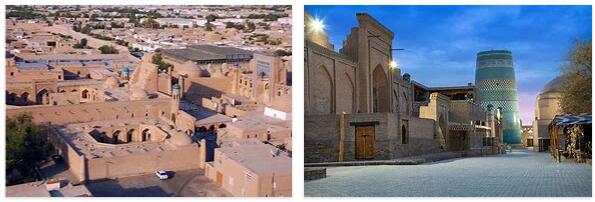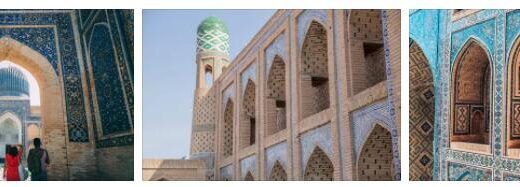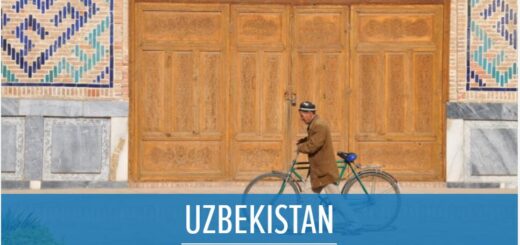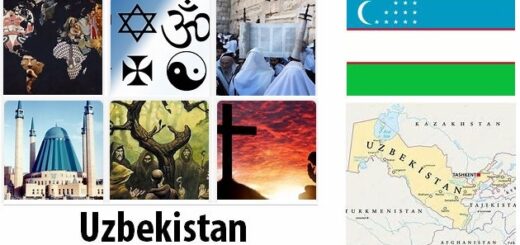Old Town of Ichan-Kala in the Oasis City of Khiva (World Heritage)
Ichan-Kala was once an important resting place on the Silk Road. The old town is still surrounded by a wall up to 10 m high. Most of the buildings date from the 18th and 19th centuries. The main attractions are the Djuma mosque and the four gates of the city wall.
Old town Ichan-Kala of the oasis city of Khiva: facts
| Official title: | Old town Ichan-Kala in the oasis city of Khiva |
| Cultural monument: | Ichan-Kala, the old town of Khiva with an area of only 400×720 m, surrounded by bastions and a 10 m high defensive wall; until the Arabs invaded the center of the ancient Persian religion of Parsism; Architectural monuments such as the Dascht Darwase and Ata Darwase gates, the Ak and Dschuma mosques with an inner courtyard surrounded by 213 columns, the Pahlawan Mahmud mausoleum, resting place of the poet Pahlawan Mahmud (1237-1325), the madrasas Shir Ghazi Khan and Amin Khan with living space for 99 students |
| Continent: | Asia |
| Country: | Uzbekistan |
| Location: | Khiva, northwest of Bukhara |
| Appointment: | 1990 |
| Meaning: | the former resting place of the caravans on the Silk Road and an important example of Islamic building in Central Asia |
Old town Ichan-Kala of the oasis city of Khiva: history
| 712 | Invasion of the Arabs |
| 10th century | Construction of the Juma Mosque |
| 1306 | Construction of the Said Allaeddin mausoleum |
| 1592 | Capital of Khorezmia |
| 1616-23 | Construction of the Arab Khan madrasah |
| 1715-30 | Khan Shir Ghazi |
| 1851/52 | Completion of the Amin Khan madrasah |
| 1855 | Completion of the Kalta Minar, the »Short Minaret«, with a height of 28 m |
| 1873 | Recognition of the sovereignty of the Russian tsar by the Khiva Khanate |
| 1910 | Construction of the Islam Hodja madrasah |
| 1920 | Deposition of the Khan of Khiva |
| 1923 | Division of Central Asia into five Soviet republics |
Between red sand and black desert
“So spoke Zarathustra”… for the average European it is synonymous with the work of the classical philologist Friedrich Nietzsche and the sounds of a symphonic poem whose musical leitmotif is always good for a cold shiver of awe. While the ancient Persian religious founder Zarathustra – he founded the so-called »Parsism« – experienced an astonishing »renaissance« in the distant Europe of the 19th century, a thoroughly Muslim one has established itself in the meantime in Khiva, one of the last strongholds of Parsism Attitude to life.
Khiva, once shrouded in secrecy on the Silk Road khanate, was a transshipment point for almost all luxury goods in the Orient. Carpets, slaves and spices changed hands, even if not entirely voluntarily. Due to its unique architectural cohesion, the picturesque old town of Chiwa is only too happy to be given the character of a “refined” centuries-old way of life and building tradition. That is true in the essence of the matter. But the buildings themselves turn out to be predominantly completely overhauled products and Itschan-Kala, the strictly geometrically walled old town and “magical world” of the Far East, as splendid Muslim “historicism”.
Khiva shared the fate of many flourishing communities at the seams of great cultures. Fraternal wars, frequent earthquakes and ruthless looting thoroughly cleaned up the historical substance of the dangerously attractive resting and transshipment area in every respect. In retrospect, life in the independent khanates of Central Asia was like dancing on a volcano. Alluring wealth, unscrupulous power politics and, above all, the varnish of oriental culture and scholarship created an environment which, although politically unstable, produced cultural excellence. The impressive architecture of Chiwa has nothing in common with the extremely fashionable “retro styles” of the present, but very much in common with the nature of any genuine historicism that glorifies the greatness of the past and transposes it into the present.
It was not until the end of the 19th century, the thoroughly unromantic scene of the beginning industrial revolution in the western world, that the political situation in distant Central Asia gradually calmed down. In this late flowering of Chiwa, which lasted only a few decades, in which the destroyed heritage was persistently restored and new things were added to the traditional canon of forms, the shape of the old town we know today emerged. The precision of the colorful brick ornaments, which give the outer walls of the numerous representative buildings their unmistakable character, testifies to a solid craftsmanship that could only survive on the basis of old traditions. It is certainly a subtle coincidence that the characteristic shape of the local minarets is reminiscent of an elongated truncated cone and thus strikingly of the factory chimneys of the western industrial districts that were built around the same time. However, it is all too understandable that the longing for the “Arabian Nights” in the shadow of these smoking chimneys produced a particularly pronounced wanderlust. Visit clothesbliss.com for travel to Asia.
The exotic beauty of the old town, in which for the modern observer – including the adventure-seeking travelers of the 19th century – the oriental way of life and unspoilt romanticism seem to be combined, has always turned out to be both a curse and a blessing for Khiva. It is only little consolation that the core city was declared a “museum” during the unpopular times of “Soviet” occupation. The zeal for reform of the young socialist state secularized the culture of Islam, which had existed since the 7th century, in a way that was hardly less ruthless than it had erased the Zoroastrian religion of ancient Persia.



